In this edition of the MIMOCA Magazine we look at printmaker Shiko Munakata (1903–1975), plus Sofu Teshigahara, Hiroshi Teshigahara, and Michel Tapié, also guests at the Inokuma home in New York, focusing primarily on works from the collection that show the association between Munakata and Genichiro Inokuma.
Reacquaintance
As well as works by Genichiro Inokuma, MIMOCA houses a number by other artists, plus various archive materials, all formerly in Inokuma's possession. Here I should like to present works and materials that elucidate the connection between Inokuma, and printmaker Shiko Munakata (1903-1975).
At this stage we do not know when the pair first met, but their paths did cross on a number of occasions from early in their respective careers.
The first such point of contact was the Japan Print Association, established in January 1931 with Saburosuke Okada as chairman, for the purpose of promoting the art of printmaking.
Munakata was one of 32 new members to join in 1932, with Inokuma joining the following year, along with Koho Hiroshima, Ryohei Koiso, and Uichi Takayama.
The second was in 1936, when both took part in the art competition at the 1936 Olympics. Both entered prints (Inokuma Shooting, and Munakata Long distance running and Gymnastics), with exhibitions being held in two locations: the Tokyo Prefectural Art Museum (March 28-April 3, 1936), and Berlin (July 15-August 16, 1936).
Neither went to Berlin, but they may well have met at the Tokyo Prefectural Art Museum exhibition.
Next, an anecdote from the late Isamu Noguchi.
When Inokuma and Sofu Teshigahara visited Noguchi in 1952 while he was occupying a cottage on Rosanjin's property in Kita-Kamakura, Yusaku Kamekura and Shiko Munakata were also visiting Rosanjin. The resulting gathering culminated in one of the men (unfortunately we will now never know who...) dancing so energetically that the tatami fell through the floor boards.
One can well imagine the merriment that ensued.
Also, in a postcard received from Munakata in February 1955, before Inokuma went to the United States, Munakata notes that Inokuma is always helping him out, and says he would therefore like to pay him a visit.
This also confirms that the pair were friendly in the early 1950s at least.
Following on from all this, Inokuma, by now settled and working hard in his New York studio, was reunited with Munakata in 1959 after a number of years when the latter visited the US for the first time, as a guest of the Rockefeller Foundation and Japan Society.
Shiko Munakata and Genichiro Inokuma in New York Photographer unknown
By now Inokuma had been in the US for over four years, undertaken a stylistic transformation into abstract painting dominated by black and white tones, and had shown work at exhibitions in America and elsewhere in addition to three solo shows at the Willard Gallery with which he was affiliated.
Shiko Munakata's solo exhibition in New York
On January 26, Munakata departed from Yokohama on his first journey to the United States, on the combined cargo-passenger vessel Yamakimi Maru, accompanied by his wife Chiya, and son Pariji.
After a stop in San Francisco, he arrived in New York in February, staying until October, apart from a summer trip to Europe, before returning to Japan on November 15.
During his time in the US he took part in numerous exhibitions, including the solo show "SHIKO MUNAKATA Woodblock prints" at the Willard Gallery (March 31-April 25, 1959).
This was his second solo outing at the Willard Gallery.
The first had been in 1952, an exhibition of Munakata's works at the Willard Gallery on the occasion of Soetsu Yanagi traveling to America with Bernard Leach and Shoji Hamada to give lectures and pottery demonstrations at over ten universities, including Black Mountain College.
It was Munakata's first solo exhibition overseas, held in this case with the artist in absentia, but his works caught the eye of the gallery owner, and another exhibition was planned as soon as news came that Munakata would be traveling to the United States in 1959.
Invitation design
Among Inokuma's former possessions is an invitation to Munakata's exhibition. It is folded in three concertina-style, then in two, and has just the name "Shiko Munakata" printed on it in large Japanese characters.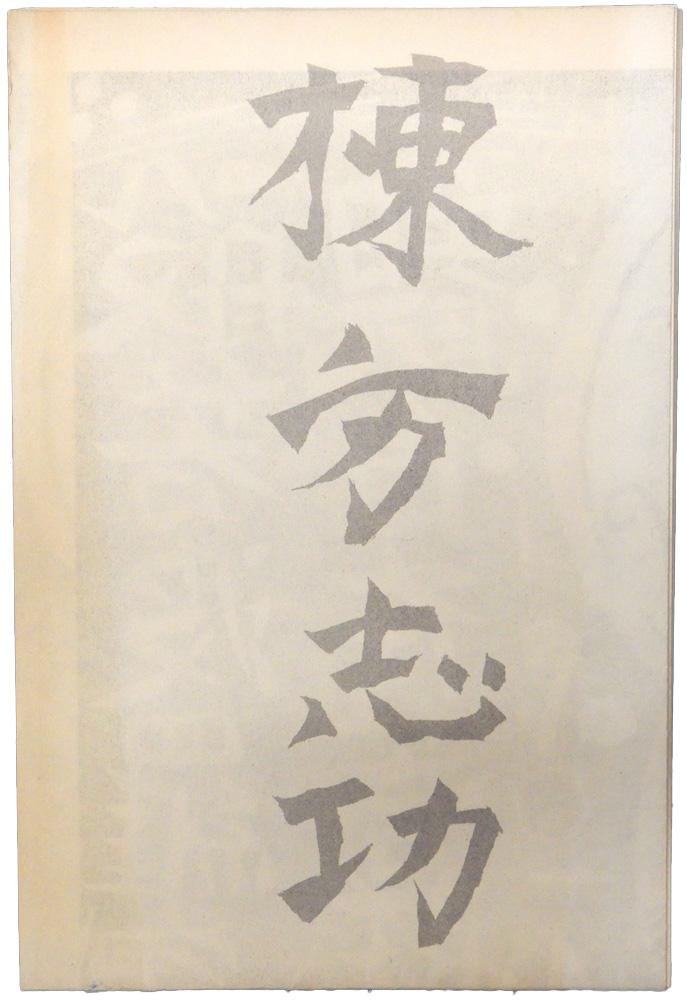
Invitation to "SHIKO MUNAKATA Woodblock prints," folded
On receiving the invitation, the recipient would first note the four characters of Munakata's name. Details of the exhibition would appear when they unfolded it.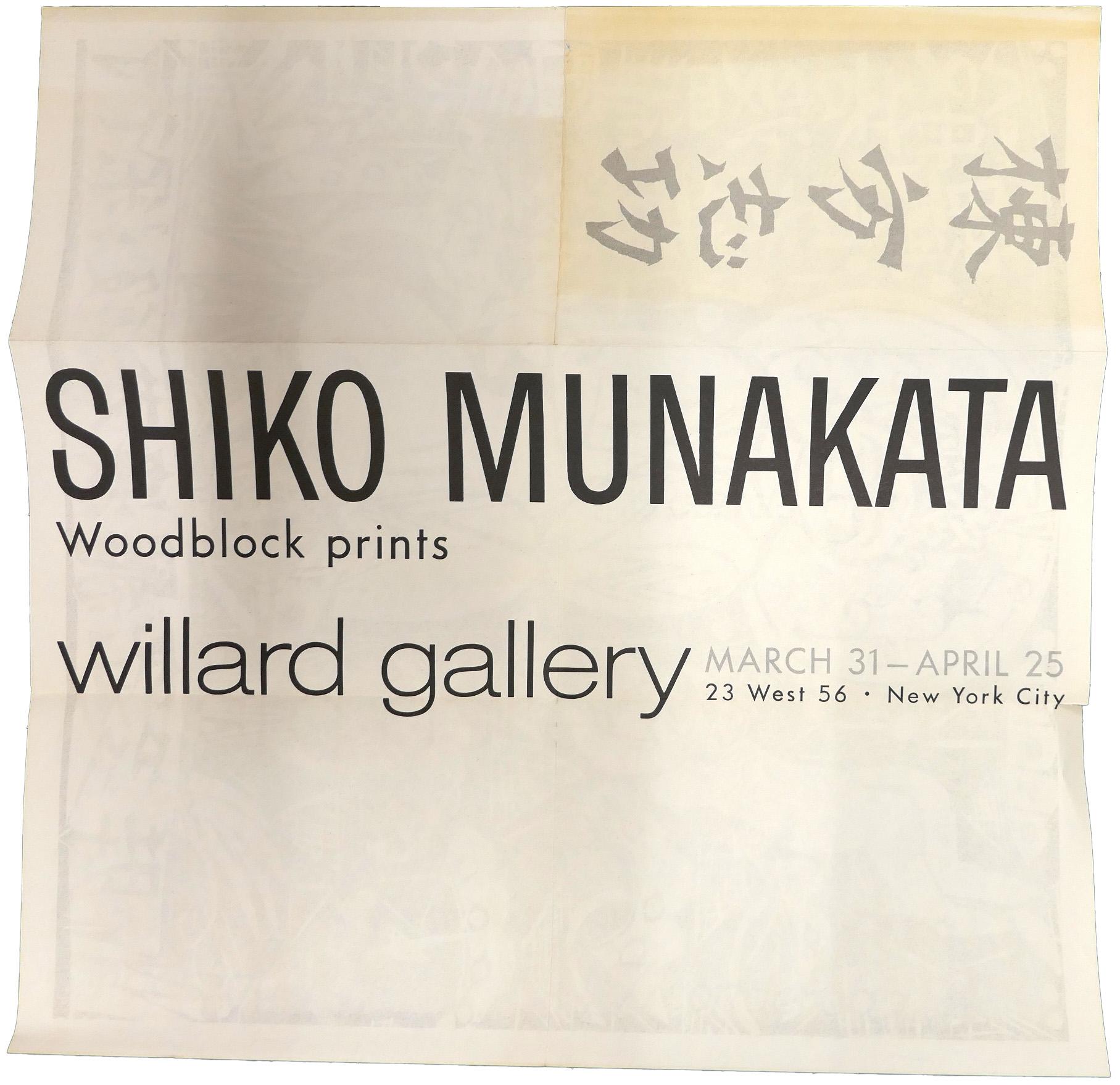
Invitation to "SHIKO MUNAKATA Woodblock prints," front, 35.3 x 35.3 cm
Note the text concentrated in the center of the sheet, dominated by the artist's name in large type from edge to edge, then the gallery name.
Both using Helvetica font (new in 1957) to simple, understated effect.
So what catches the eye next?
"Woodblock prints," subtitle of the exhibition; the exhibition dates March 31-April 25, and the address 23 West 56 ・New York City, all printed in the geometric, refined Futura, released in 1923.
All in all, a design in which great care has been taken with the use of different fonts and color tones, and of blank space.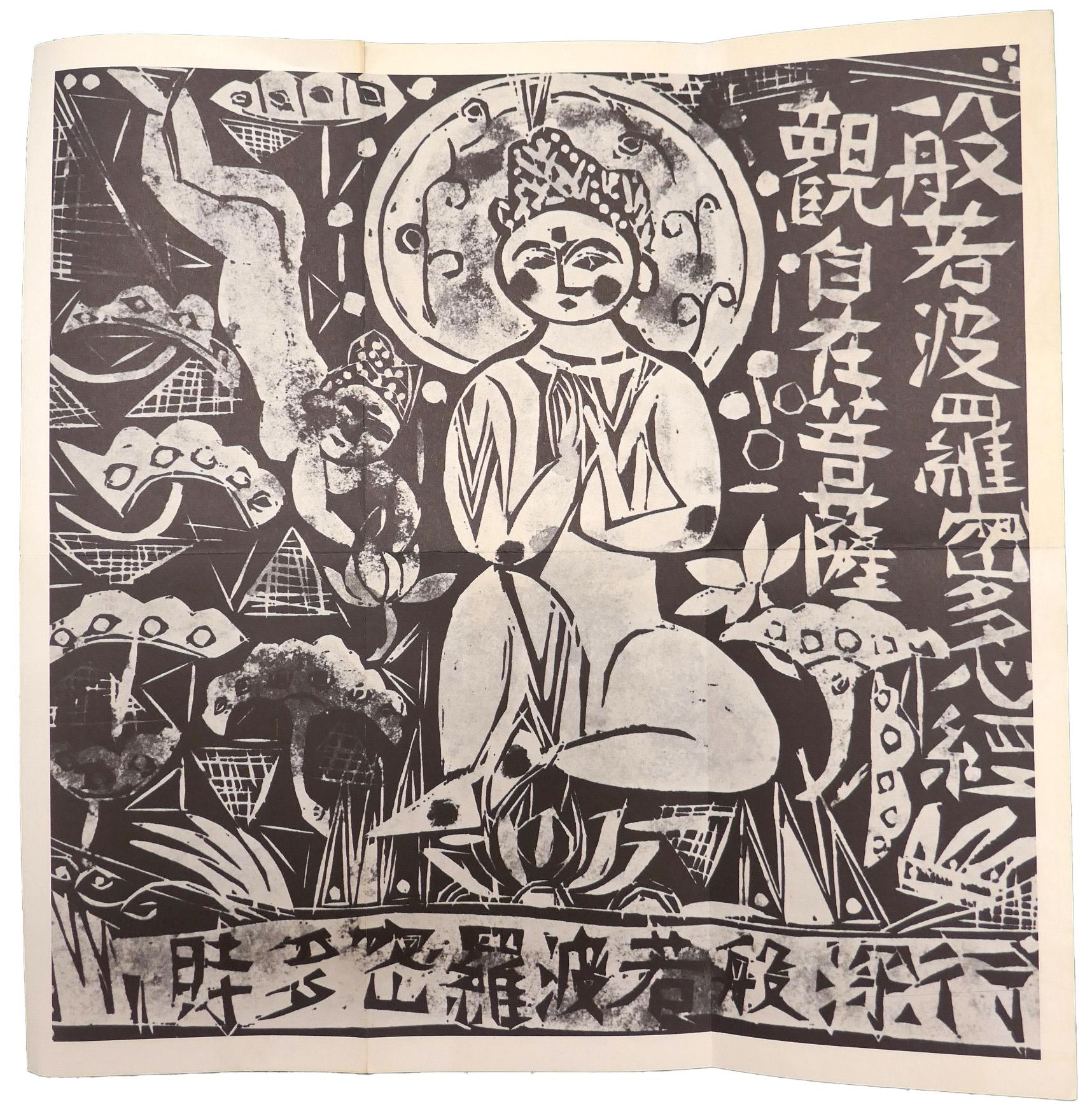
Invitation to "SHIKO MUNAKATA Woodblock prints," back, 35.3 x 35.3 cm
Printed on the reverse of the invitation is Freedom, from the series "The Heart Satra. Second Series" of 16 woodblock prints (1957), a glorious composition incorporating the Kannon bodhisattva, various designs, and the text of the Heart Sutra.
Commenting on the finished invitation, Munakata noted glowingly,
"It was truly splendid, and I was truly grateful." (Geijutsu Shincho magazine, May 1959, p. 111)
So whose design was it?
I'm sure you've worked it out already.
That's right, Inokuma's.
When it came to displaying the works too, Inokuma came prepared, with hammer, nails, ruler, spirit level, and even a saw, and dived right in.
During Munakata's time in New York, Inokuma, with his wife Fumiko, was the only one of the Japanese painters in the city that he visited and spoke with every day.
At his Willard Gallery exhibition he showed 50 works, including Floral Variations (1935, woodblock print on paper), Two Bodhisttva and Ten Great Disciples of Sakyamuni (1939/partially revised in 1948, woodblock print on paper), In Praise of Beethoren's Fifth Symphony (1951, woodblock print on paper), Wandering away from Home (1953, woodblock print on paper).
Of these, Two Bodhisttva and Ten Great Disciples of Sakyamuni was one of Munakata's best known, having been submitted to the 1955 Sao Paulo Biennale (winning top prize in the print category), and 1956 Venice Biennale (Gran Premi in the print category).
It is not hard to see how much enthusiasm and effort went into this New York showcase for his work.
Shiko Munakata Genkan
This is the Munakata work in the MIMOCA collection.
Shiko Munakata, Genkan, 1959, ink on paper, 78 x 145.5 cm (framed)
Apologies for the reflections off the glass cover, which make the work a little hard to see.
Munakata's powerful lines, rendered in unhesitating brushstrokes, are suffused with drive and determination.
"Genkan" was a favorite word of Munakata's, often used in his calligraphy and paintings.
He employed it in the Buddhist sense of a "gateway (kanmon) to the path of mystery (genmyo)."
Meaning a portal to esoteric Buddhist training, perhaps.
Genkan was originally the term for the entrance to the lecture hall (shoin) of a temple--indeed a gateway to the path of mystery--and from that came to be used as a general term for the front entrance of a building.

Shiko Munakata, Genkan (detail)
In the blank spaces are Munakata's presentation signature and seal, plus the words:
For my dear friends the Inokumas
In New York Shiko Munakata
April 27, 1959 A night with a lovely moon
From this we can confirm that the work was made for the Inokumas on the night of April 27, 1959.
Its well-preserved state suggests that Inokuma greatly valued this gift from Munakata.
And that Munakata noted in the autobiographical Ban Gokudo that Inokuma was very kind to him during his time in New York reinforces the idea of Genkan expressing the bond between the two men.
So what kind of day was April 27, 1959, when Genkan was made? The appointments diary of Inokuma's wife, Fumiko, held by MIMOCA, notes on the page for Monday, April 27, 1959, among the names of numerous visitors including "the Teshigaharas [Sofu Teshigahara and Hiroshi Teshigahara], "Tapie" [Michel Tapié], and "Steinberg" [Saul Steinberg], the name "Munakata."
From this diary entry we see that a total of 17 people visited the Inokuma home that day. As noted earlier, April 27 was two days after Munakata's exhibition at the Willard Gallery had ended.
One imagines it was a relaxed gathering, as the pace slowed a little after the show.
Incidentally the character for gen in this case (Gen) means abstruse reasoning or truth, and Inokuma's official name in his family register actually used it for the first syllable of his first name.
Munakata may well have been thinking of the "gen" of Inokuma's name when he wrote the word "genkan" as a memento of an enjoyable evening.
From the back left, Sofu Teshigahara, Hiroshi Teshigahara, Fumiko Inokuma, Genichiro Inokuma, Unknown, Michel Tapié, Shiko Munakata, Chiya Munakata Photographer unknown (From 35mm slide formerly belonging to Inokuma)
Sofu, Hiroshi, Inokuma
Of the many visitors to the Inokuma house that night, Sofu Teshigahara (1900-1979), Hiroshi Teshigahara (1924-2001), and Michel Tapié (1909-1987) were, like Munakata, in New York during their travels. 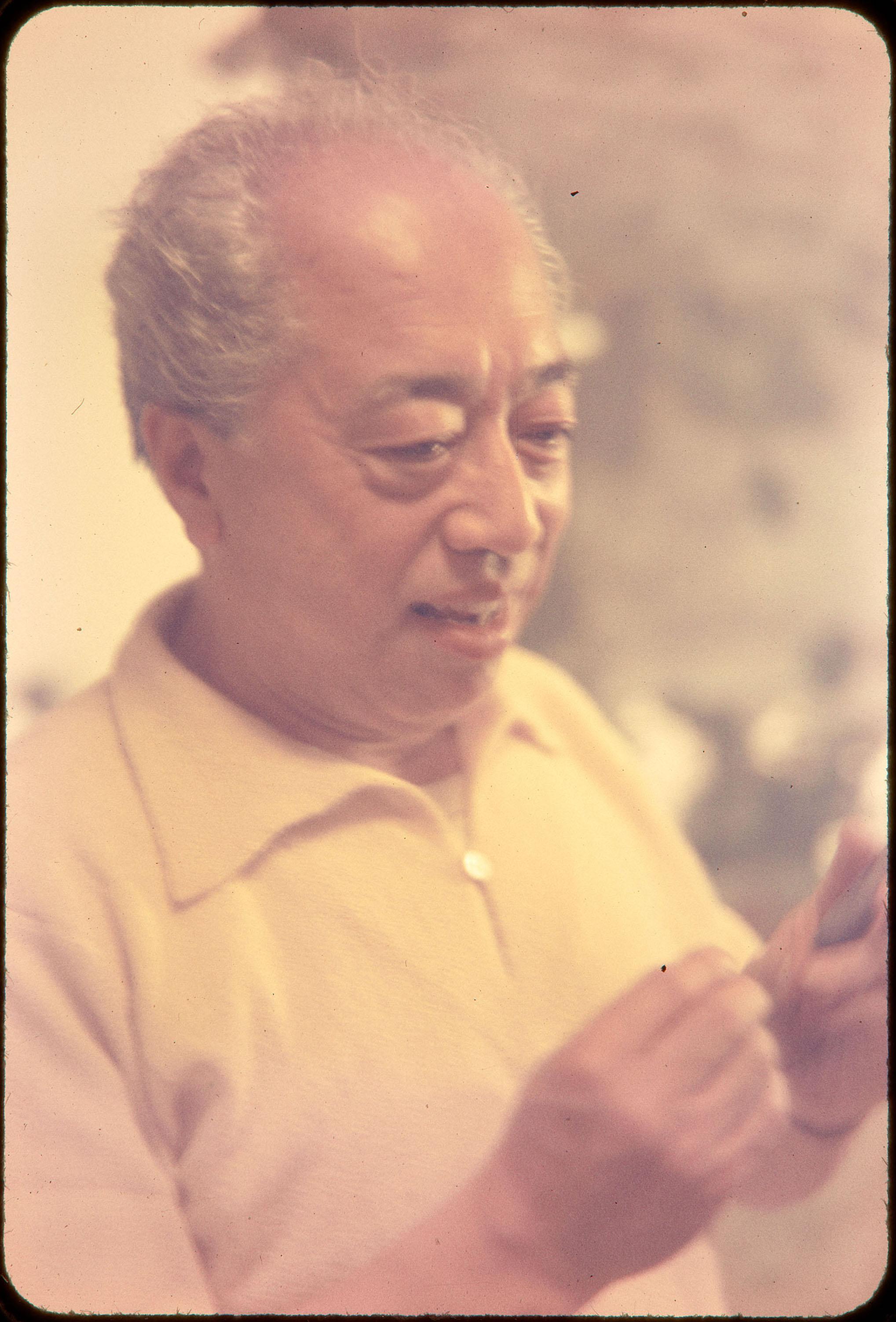
Sofu Teshigahara Photo: Genichiro Inokuma (From 35mm slide formerly belonging to Inokuma)
Sofu, high-profile founder of the Sogetsu school of ikebana, and avant-garde sculptor, had come to the United States on April 12, 1959 with his son Hiroshi, director of the Sogetsu Art Center, as part of a touring exhibition organized by Tapié taking in the US, Italy, France, and Spain.
A welcome party for Sofu was held on April 15 in New York, attended by art world figures including Inokuma, Munakata, Isamu Noguchi, Minoru Kawabata, and Yoshiaki Tono.
April 27 was after the end of Sofu's exhibition at the Martha Jackson Gallery (April 19-20, the 21st by special invitation only), with which Inokuma had assisted. 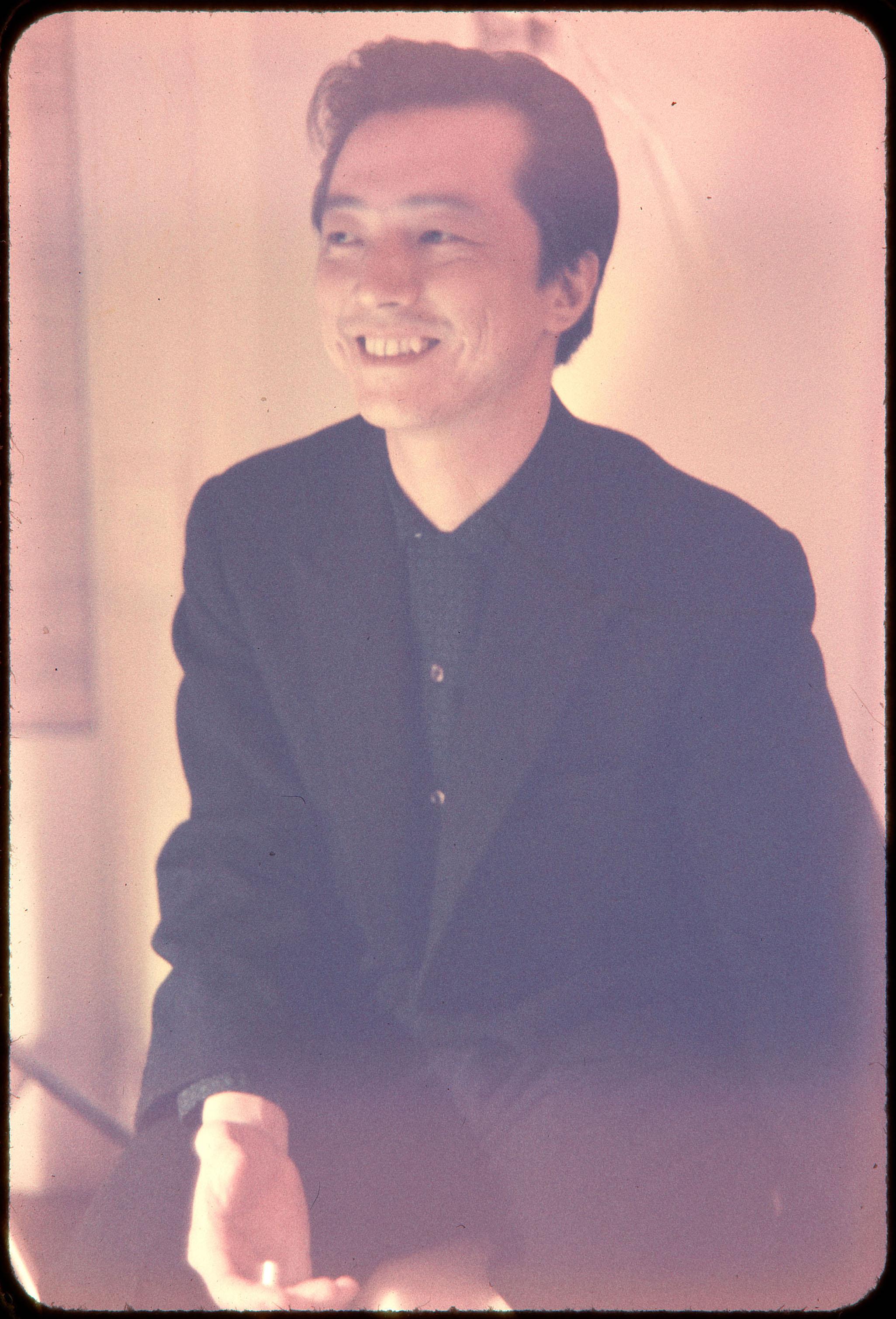
Hiroshi Teshigahara Photo: Genichiro Inokuma (From 35mm slide belonging to Inokuma)
In a letter from Hiroshi Teshigahara to Inokuma dated July 18, after Teshigahara had returned to Japan, he writes of being delighted to be shown his host's latest works on the night of April 27, plus his slides of New York streets and from his travels.
Thank you for all your support in New York. And that feast of Japanese food on the night of the 27th is one I'll never forget. I was also excited by your latest works, and slides. Thank you so much for everything. Your wife must have been exhausted after all that. Travelers just breeze in, take advantage of one's good nature, do what they like then leave, so I know it must have caused disruption for you both. After that we continued our most pleasant travels, to Paris, Turin and Barcelona. In Paris we were very well looked after by Imai and Domoto. In Barcelona I took as many photos of Gaudi as I could. The thrill of that is another thing I will never forget...
He also writes of having the film he shot of boxer Jose Torres in New York developed.
A reappraisal of Gaudi's career was underway during this period that included the exhibition "Gaudi" (December 18, 1957-February 23, 1958), staged at MoMA the previous year in a collaboration between the museum's architecture and design department, and architectural historian Henry-Russell Hitchcock.
Inokuma had the exhibition catalogue, and one can imagine he spoke about Gaudi to Hiroshi.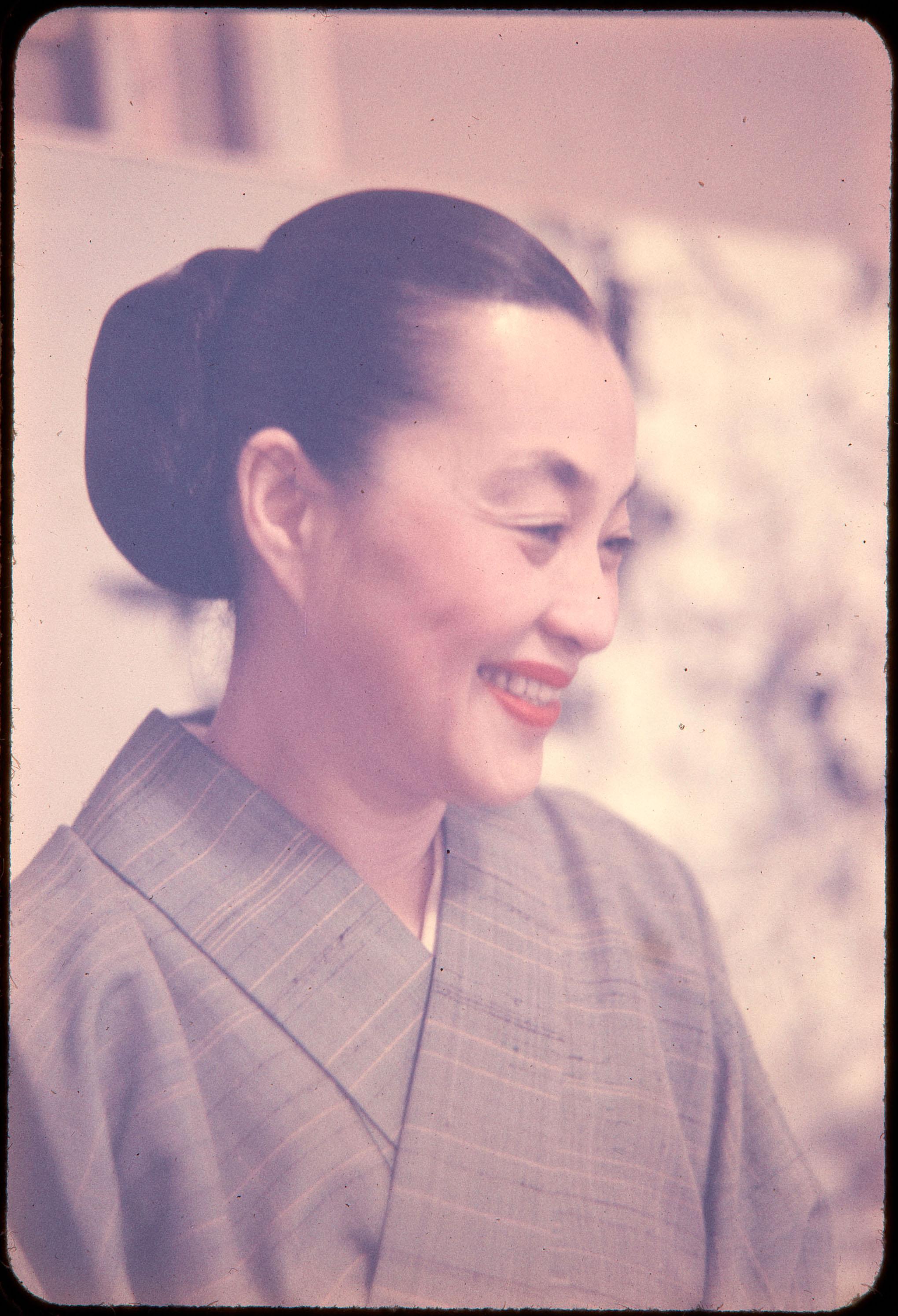
Fumiko Inokuma Photo: Genichiro Inokuma (From 35mm slide formerly belonging to Inokuma)
Tapié, Inokuma, and the Toulouse-Lautrec connection
Michel Tapié was the theoretical driving force behind Art Informel (the avant-garde art movement with a preference for irregular forms that flourished in Europe, especially France, in the 1950s), and knew about Sofu before coming to Japan, through Toshimitsu Imai in Paris.
When Tapié made his first trip to Japan, arriving on September 5, 1957, Sofu was waiting for him at Haneda Airport, and thus their association began.
Tapié ranked Sofu as one of the world's top contemporary avant-garde sculptors, and naming Sofu and Gutai as core proponents of Art Informel, enthusiastically promoted both to overseas audiences.
Tapié himself, full name Michel Tapié de Celeyran, was born into French aristocracy. His paternal grandmother was Alix de Toulouse-Lautrec (1846-1918), and the son of this grandmother's elder brother was Henri de Toulouse-Lautrec (1864-1901), making Tapié a second cousin once removed of the famous painter. Though Toulouse-Lautrec the artist had died before Tapié was even born, his legacy as the relative who had seduced the Parisian art world, was a dazzling one.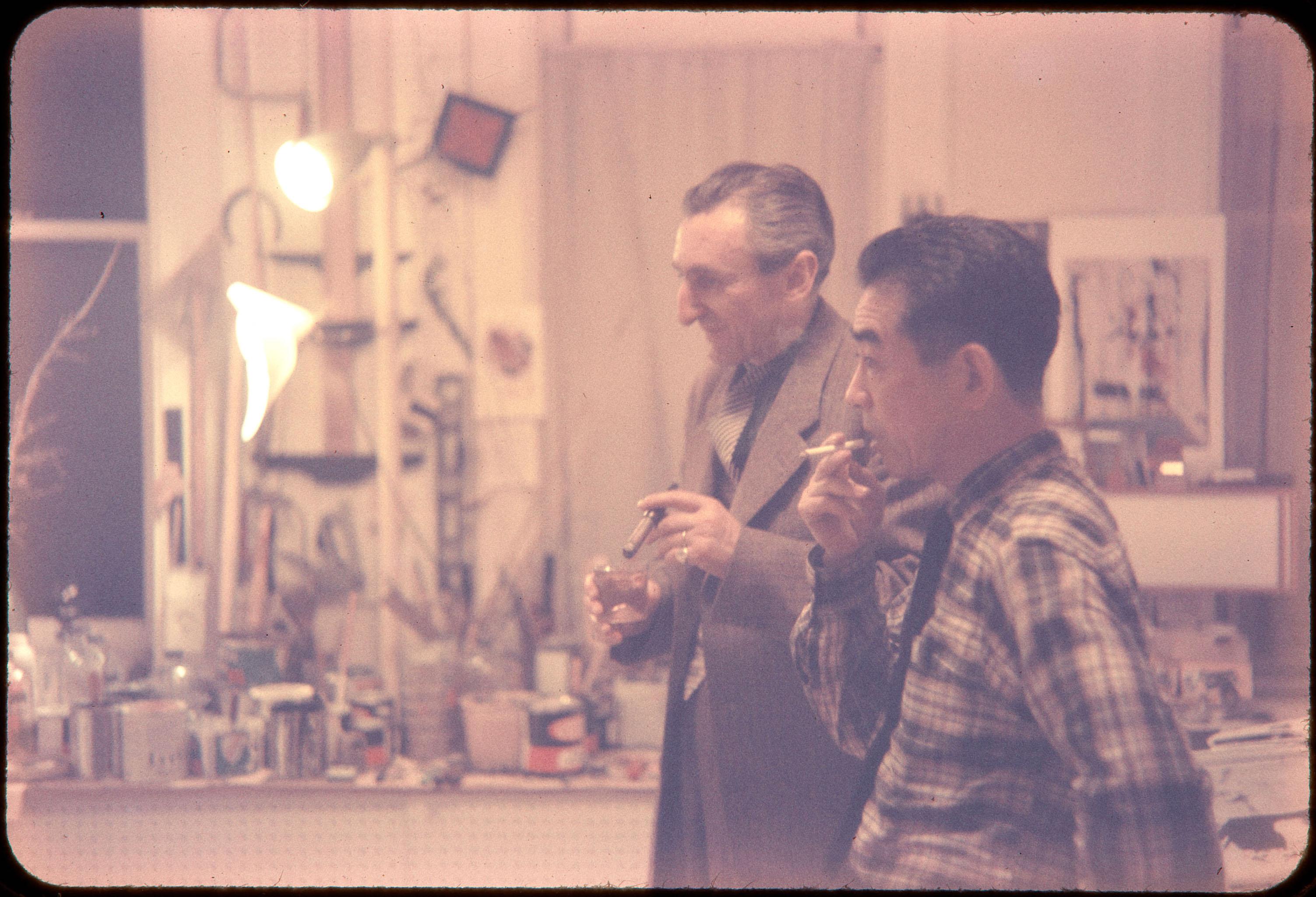
Michel Tapié and Genichiro Inokuma Photographer unknown (From 35mm slide formerly belonging to Inokuma)
Toulouse-Lautrec was a painter of special significance to Inokuma as well.
Around the time he started at the Tokyo Fine Arts School, as his classmates discussed the likes of Cezanne and Renoir, Inokuma fell for the paintings of Toulouse-Lautrec, the artist becoming Inokuma's first love, to the extent that his young Japanese admirer even dreamed about him.
I knew nothing about Toulouse-Lautrec. I was simply captivated by his paintings; that indescribable, mysterious desolation, those elegant colors. The superlative brushwork of those dynamic sketches, that spine-tingling human aura. I never gave Cezanne or Renoir a second glance after that.
(Chubu Nihon Shimbun, evening edition, July 2, 1953, p. 4)
One can only assume he was also eager to talk to Tapié about his illustrious forebear.
Inokuma works owned by Tapié
Tapié had another side, that of collector, and possessed a collection in Turin that included works by Jackson Pollock, Lucio Fontana, Gutai artists, and Inokuma.
In later years most of these ended up in other hands, the majority of the Gutai works going to collector Tokutaro Yamamura, and now being held by the Hyogo Prefectural Museum of Art as part of the Yamamura Collection.
Of the works by Inokuma that belonged to Tapié, the whereabouts of two are known. Both are in the collections of museums in the vicinity of MIMOCA.
The paintings were originally purchased by Tapié at Inokuma's New York studio. One is Weather forecast (1958, oil on canvas), now at the Takamatsu Art Museum, and the other is Composition No. 1 (1958, oil on canvas), housed in the Ohara Museum of Art. 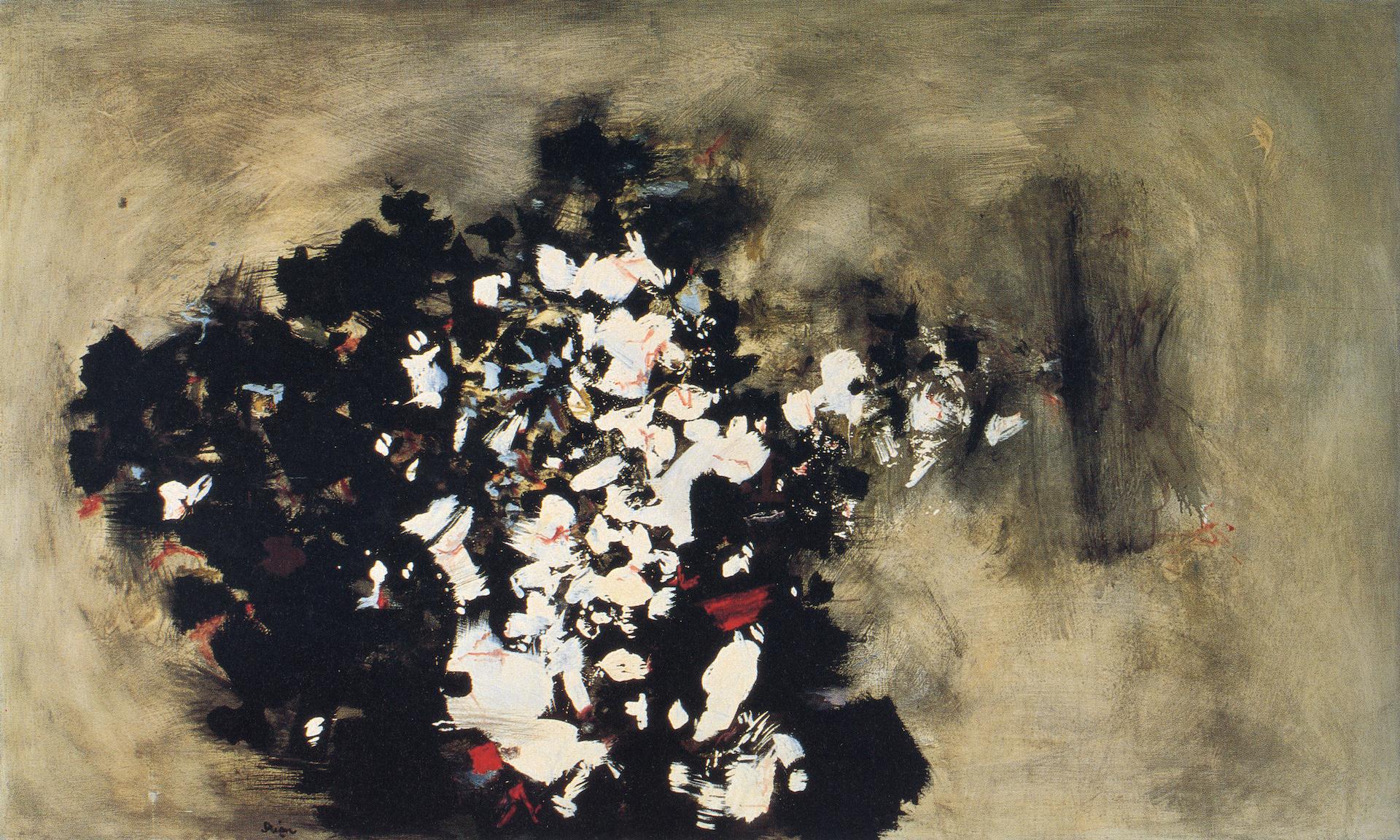
Genichiro Inokuma, Weather forecast, 1958, oil on canvas, 121 x 200 cm. Collection Takamatsu Art Museum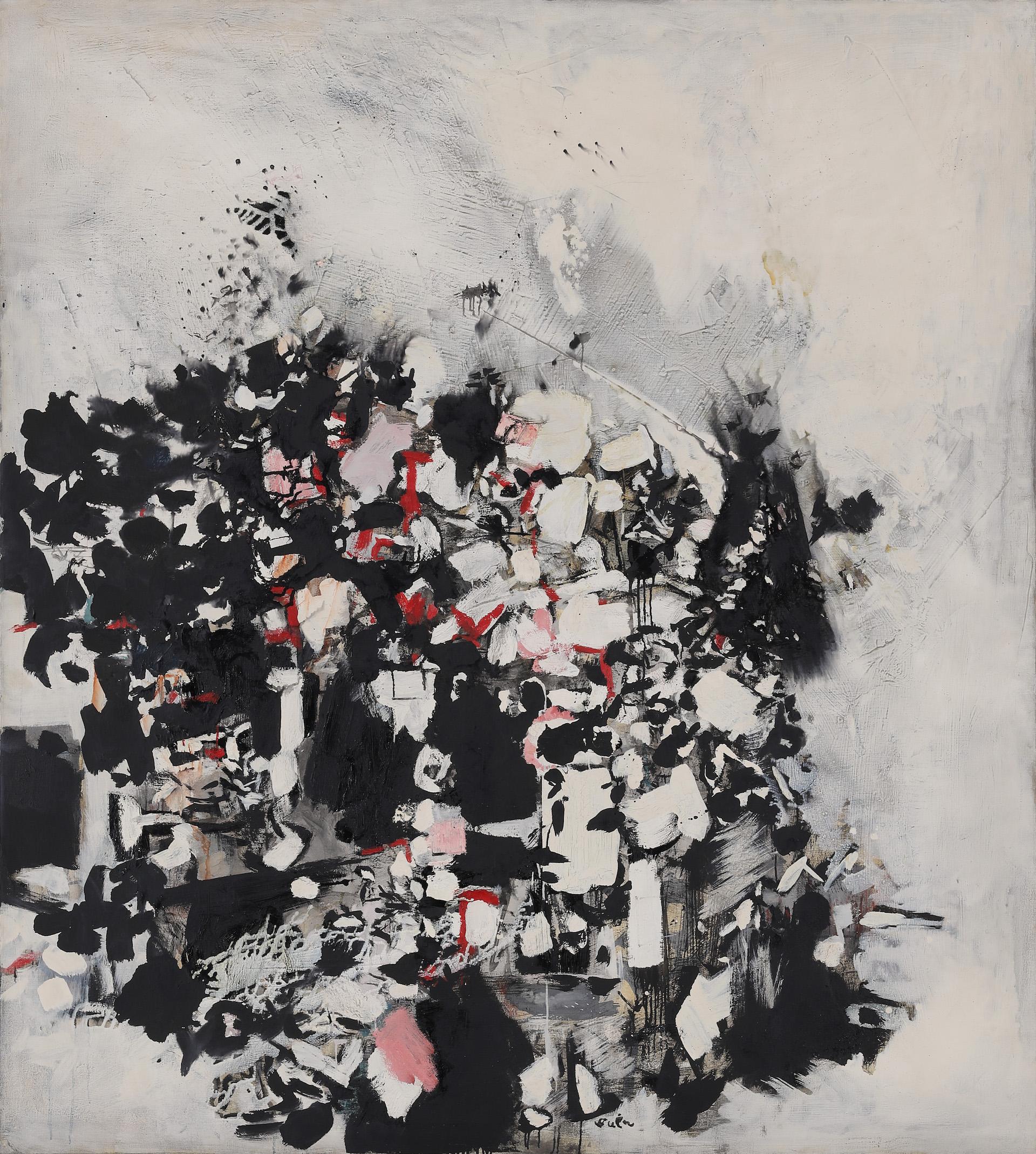
Genichiro Inokuma, Composition No. 1, 1958, oil on canvas, 205 x 181 cm. Collection Ohara Museum of Art
The Ohara Museum of Art was established in 1930 as Japan's first western art museum by Magosaburo Ohara, first president of Kurashiki Kenshoku (now Kuraray Co., Ltd.).
Magosaburo was also a supporter of the Mingei movement of Yanagi Soetsu et al, and along with his son Soichiro, was close to Munakata, and there are many of Munakata's works in the museum.
In Praise of Beethove's Fifth Symphony (1951, woodblock print on paper) exhibited at the 1959 Willard Gallery show was commissioned by Soichiro to commemorate the first Japanese production of vinylon synthetic fiber, developed by his company Kurashiki Rayon Co., Ltd. (now Kuraray Co., Ltd.).
The addition of a work from Inokuma's New York period, via the hands of Tapié, to the Ohara Museum of Art with its strong connection to Munakata, could be described as yet another link between Inokuma and the printmaker.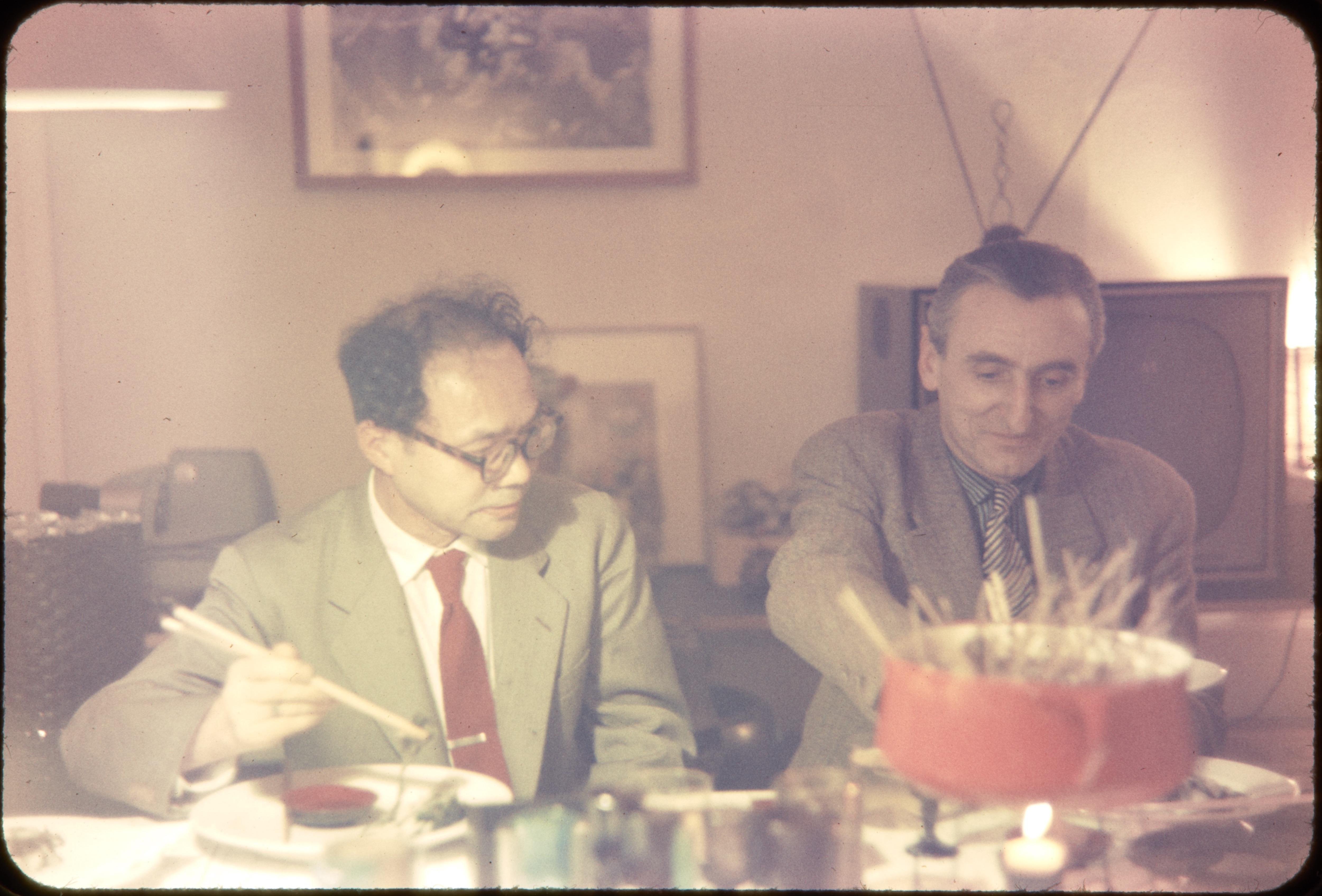
Shiko Munakata and Michel Tapié Photo: Genichiro Inokuma (From 35mm slide formerly belonging to Inokuma)
Another Munakata work precious to Inokuma
To finish, let us look at another work by Munakata that Inokuma had in his collection.
It is Ubari, from the series "Two Bodhisattva and Ten Great Disciples of Sakyamuni" (printed in 1959) one of the 12 woodcuts in Two Bodhisattva and Ten Great Disciples of Sakyamuni(1939/partially revised in 1948, woodblock print on paper), probably exhibited at Munakata's show at the Willard Gallery in 1959, mounted as a hanging scroll. 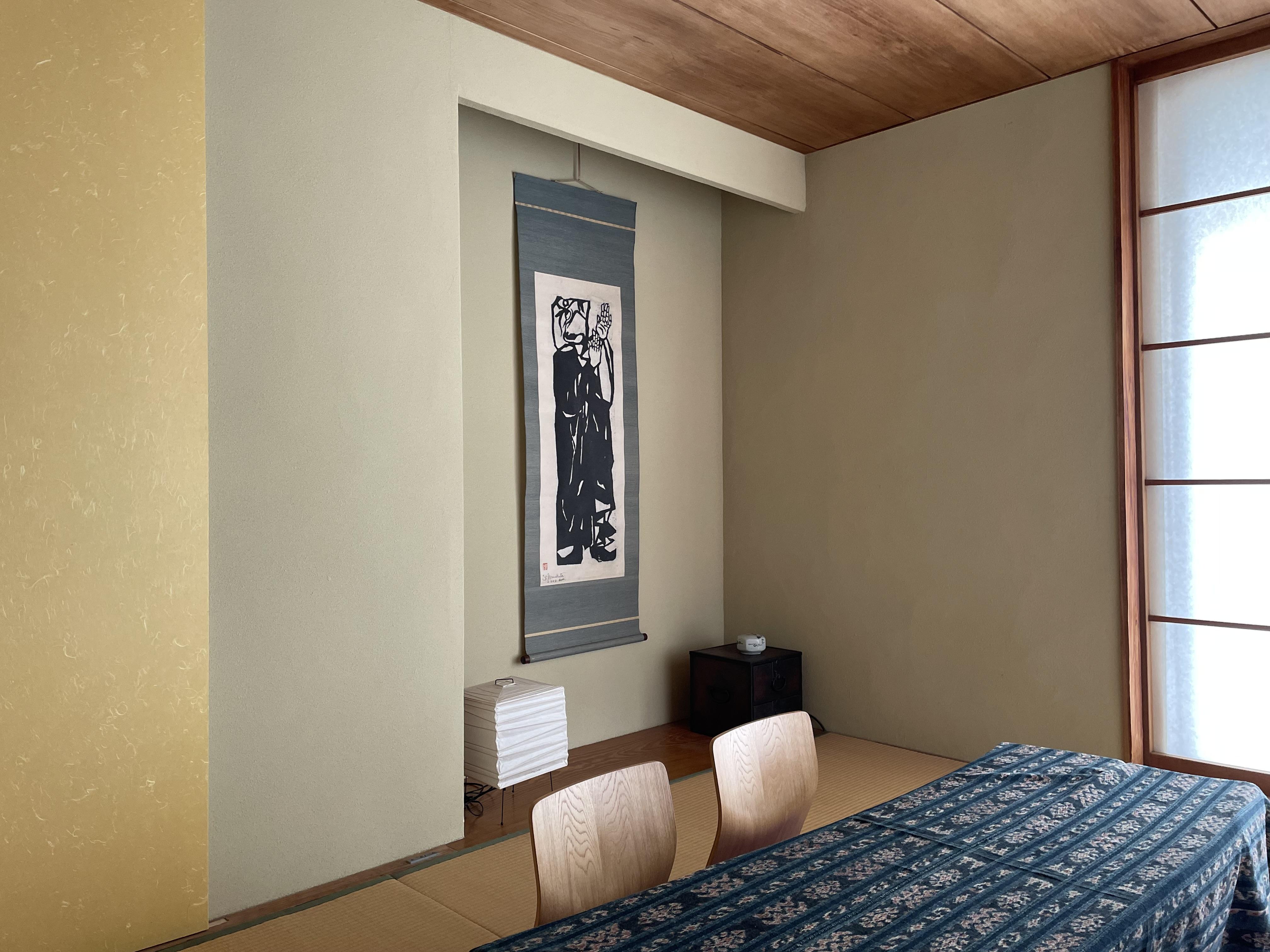
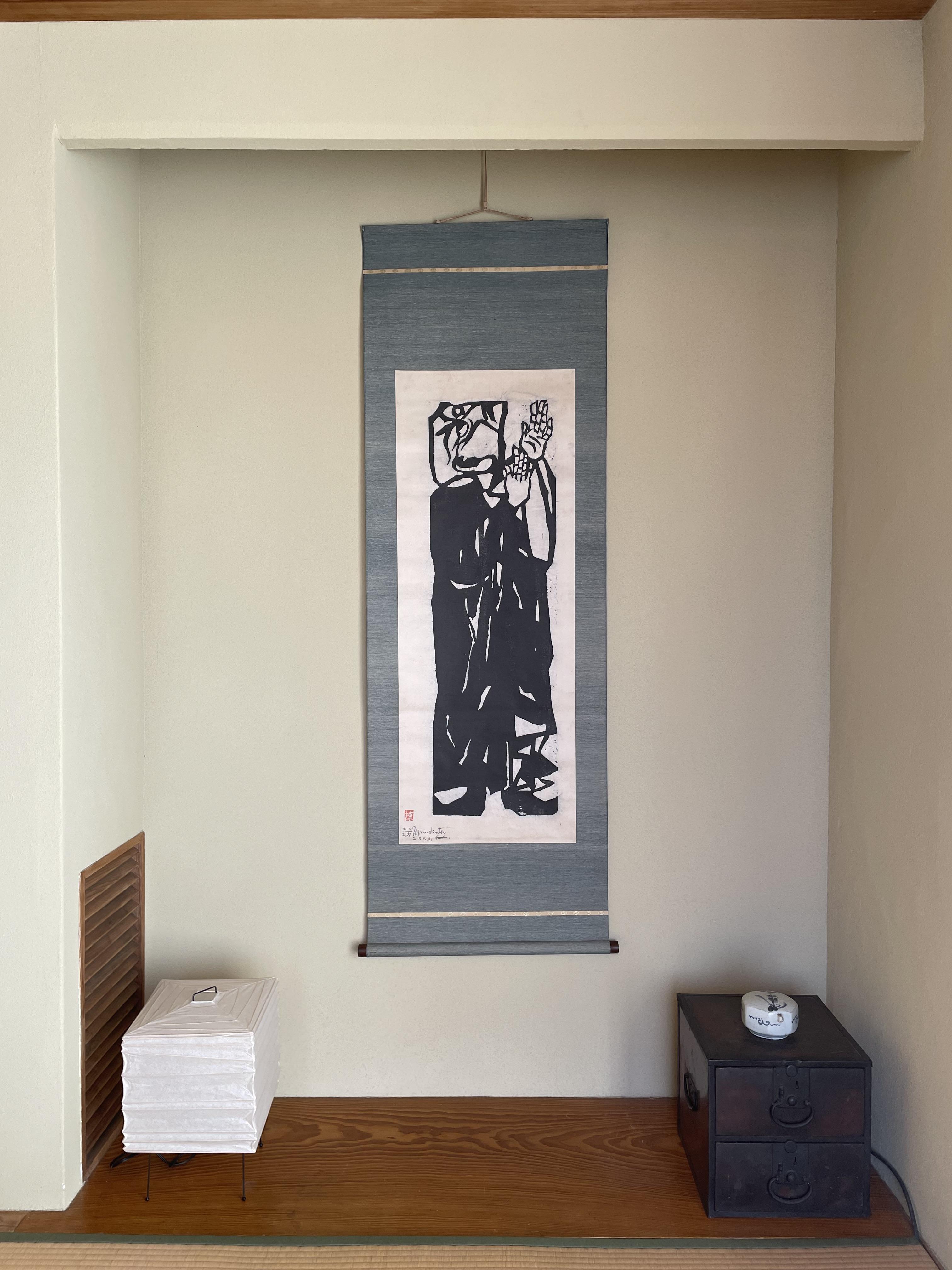

Shiko Munakata, Ubari, from the series "Two Bodhisattva and Ten Great Disciples of Sakyamuni", 1939 / printed 1959, woodblock print on paper. Private collection.
This work was displayed in the Inokumas' Denenchofu home in Tokyo when important guests came to visit.
This brings us to the end of our discussion.
We have written here about Inokuma and Shiko Munakata in New York, about their association, plus Sofu and Hiroshi Teshigahara, and Michel Tapié, who also gathered at the Inokuma home on the night of April 27, 1959.
As you know, the careers of all went from strength to strength from the 1960s onward.
We look forward to telling you more from time to time about items in the collection and what makes them special, in future editions of the MIMOCA Magazine. 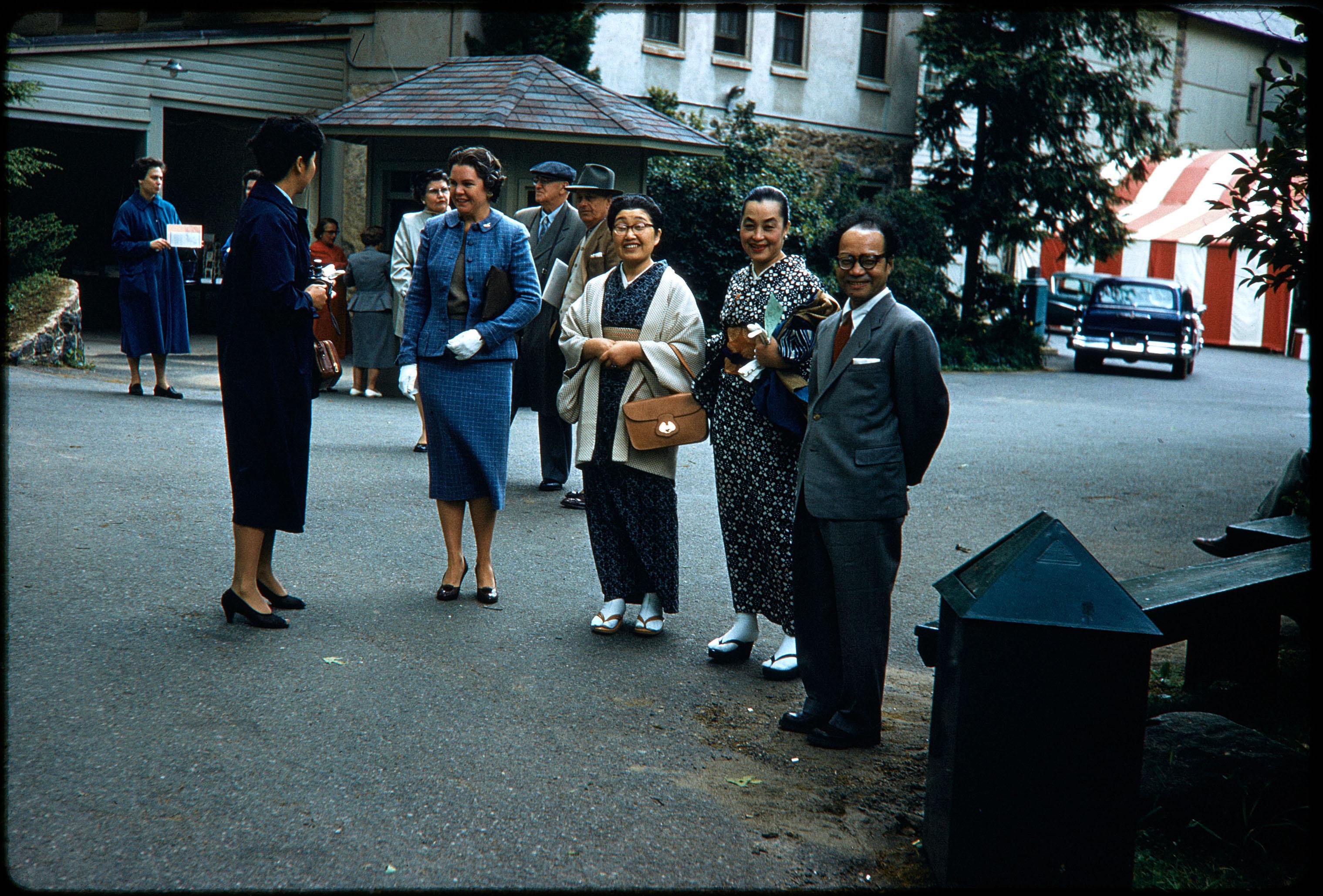
From right, Shiko Munakata, Fumiko Inokuma, and Chiya Munakata Photo: Genichiro Inokuma (From 35mm slide formerly belonging to Inokuma)
Text: Hiroyuki Yoshizawa
*Please note that the works and other materials described here are not currently on display at MIMOCA. Images not credited are all from the archives of the Marugame Genichiro-Inokuma Museum of Contemporary Art. Unauthorized reproduction of images is strictly prohibited.
